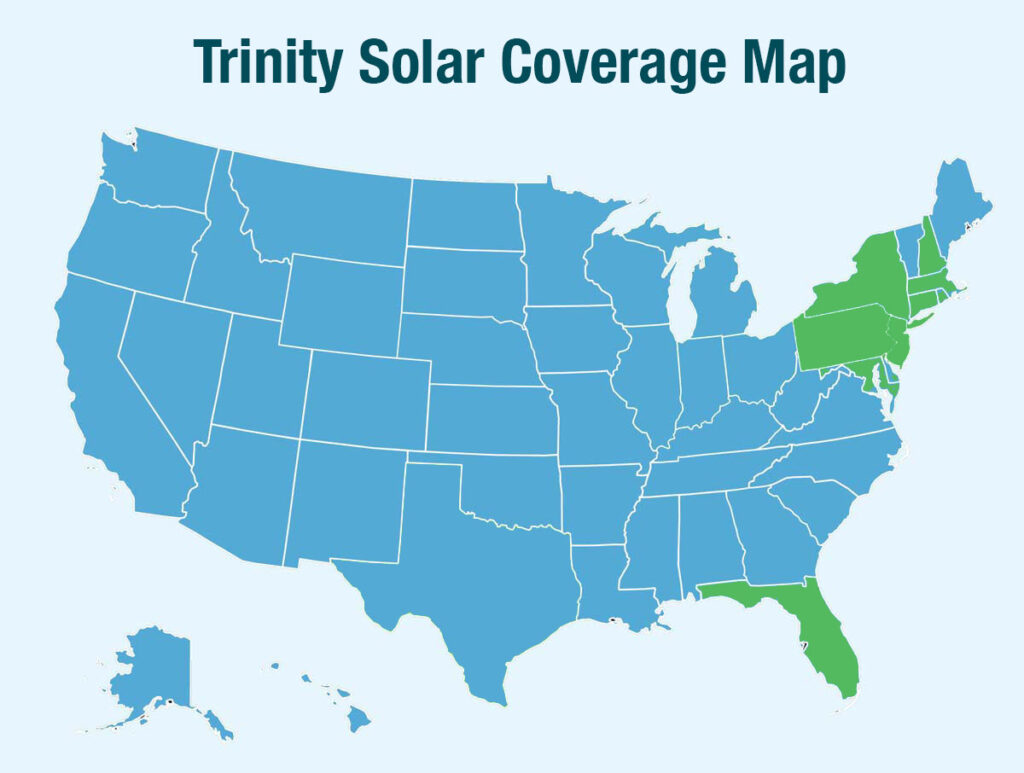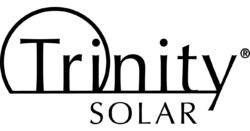- Trinity Solar has over 30 years of experience and has installed systems for more than 100,000 homes across the East Coast.
- All design and installation work is done by Trinity’s own certified teams, not subcontractors.
- They offer cash purchase, loans, leases, and PPAs, with special emphasis on $0-down options.
- Systems come with up to 25-year warranties, and you’re assigned a project concierge for personalized support.
About Trinity Solar: Experience You Can Trust
Trinity Solar has been family‑owned and operated since 1994, blending three decades of expertise with personalized service. Headquartered in New Jersey and proudly privately held, the company employs over 3,000 in‑house staff, including certified installers and consultants. They pride themselves on being a stable, family-owned business in an industry filled with fly-by-night operators. They emphasize local relationships, their installers live in the communities they serve, and they’ve built strong ties with local utilities, inspectors, and regulators to smooth the installation process. This isn’t a faceless corporation; it’s a company where your project manager might just live down the street.
The Trinity Solar Quote Process
Trinity’s quoting journey starts with a free consultation, aimed to be casual yet thorough. You’ll book a free, 60-minute consultation either online or by phone. A Trinity Solar Expert visits your home (or connects virtually) to assess your roof, review past electricity bills, and discuss your goals. They’ll provide a customized design and savings estimate, explain financing options (cash, loan, lease), and outline available incentives, all with no obligation. Users often praise their reps for being “casual but super informative.”
Installation Process
Once the contract is signed, here’s how it flows:
- Meet & Design: After your consultation, their engineering team creates a custom system. They handle all permits, HOA approvals, and utility paperwork, a major headache they lift off your shoulders.
- Pre-Installation Prep: Once permits are secured (typically 2–8 weeks, depending on local regulations), they schedule your install date.
- Installation Day(s): A Trinity crew (mostly in-house, not subcontractors) arrives and typically completes the job in 1–3 days. Customers highlight their professionalism and tidiness.
- Activation & Monitoring: After installation, Trinity coordinates with your utility for final inspections and “Permission to Operate.” Once live, you’ll use the SolarEdge or Enphase app to track your energy production and savings.
Trinity Solar Coverage Area

Trinity Solar operates in 10 states, primarily in the Northeast and Mid-Atlantic, plus Florida. They’re a regional powerhouse, not a national player like Sunrun. Trinity currently serves 10 East Coast states: Connecticut, Delaware, Florida, Maryland, Massachusetts, New Jersey, New York, Pennsylvania, Rhode Island, and New Hampshire.
Major Cities Covered:
- New Jersey: Newark, Jersey City, Trenton
- New York: NYC (all boroughs), Long Island, Albany
- Massachusetts: Boston, Springfield, Worcester
- Pennsylvania: Philadelphia, Pittsburgh, Allentown
- Florida: Orlando, Tampa, Jacksonville
Equipment Offered
Trinity offers a wide selection of tier‑one solar panels and inverters, tailored to different budgets and energy goals. While they don’t list specific brands upfront, you’ll review them during your quote. They also offer energy storage with batteries, for backup power and time‑of‑use optimization. Trinity focuses on industry-standard, Tier-1 equipment known for reliability over cutting-edge exotic options:
- Solar Panels: Primarily Qcells (efficiency: ~20.6%–21.4%), with 25-year product and performance warranties (86% output guaranteed at year 25).
- Inverters: Mostly SolarEdge (with power optimizers) or Enphase microinverters. SolarEdge offers 12-year warranties (extendable to 25 years).
- Batteries: Tesla Powerwall and Generac PWRcell, ideal for backup power or maximizing self-consumption.
- Other: System monitoring apps, EV charger integration, and crucially, roofing services. If your roof needs repair or replacement before panels go on, Trinity handles it
Payment Options
Trinity aims to make solar accessible through multiple paths:
- Cash Purchase: Highest long-term savings (~$20k-$25k for an 8kW system before 30% federal tax credit).
- Solar Loans: Offered in-house or via partners; $0-down options available (most popular choice).
- Leases/PPAs: Administered through partner Sunnova. $0-down, but you pay monthly for the energy (lease) or the system (PPA). Caution: Escalator clauses (~2.9% annual increase) may reduce savings over time.
Warranty & Support
They back systems with industry‑leading warranties:
- Solar & roofing warranties up to 25 years, covering materials, workmanship, and repairs.
- Inverters: 12 years (extendable for SolarEdge).
- Batteries: 10 years (Tesla/Generac).
- Workmanship: Only 5–10 years—below the industry average of 10–25 years. *Lease/PPA customers get full coverage for the agreement term (e.g., 25 years)*.
- Roof Penetration Warranty: 10–25 years against leaks
Customer Support: Mixed reviews exist. Praise centers on design/install teams; complaints cite slow repair responses or post-sale follow-up. Trinity has an A+ BBB rating but responds actively to complaints.
- In‑house installation ensures accountability.
- A+ BBB rating and active responses to complaints (though some service delays have been noted).
- Customer support includes a Project Concierge and rapid responses to issues, but note some reports of warranty hiccups or slow repairs especially on sensors and 3G monitoring updates.
Cost & ROI
Nationally, Trinity’s paid systems cost on par with other major installers. ROI depends on your location, but typical solar systems offer a 6–12 year payback, saving thousands over 20–25 years. They leverage solar tax credits and local incentives. Their flexible financing (purchase or loan) can improve returns, whereas leases/PPA may reduce ROI due to escalators.
- System Cost: ~$2.50–$3.12 per watt (e.g., $20,000–$24,960 for 8kW before incentives).
- Federal Tax Credit: Slashes cost by 30% (e.g., $24,960 becomes ~$17,472).
- Typical Payback Period: 6–10 years in high-electricity-rate states like NJ, NY, or MA.
- Long-Term Savings: Customers report 50–70%+ reductions in electric bills. One noted, “What I’ve saved over the years is remarkable.”
Pros & Cons
Pros
- 30+ years in business with 100,000+ installs
- In‑house certified installers
- Comprehensive solar + roofing + battery solutions
- Solid warranties and fast customer service
- Competitive pricing vs. peers like Sunrun
- $0-down loans/leases/PPAs available
Cons
- Only 5-10 year workmanship warranty
- Operates only in 10 East Coast states
- Some service and support delays, especially for leased systems or monitoring updates
- Pushes lease/PPA options with escalators that may limit savings
- Equipment brands aren’t listed upfront, they’re disclosed later
Things to Consider
- Decide if a loan or purchase is better for your long‑term ROI vs. lease/PPA.
- Be sure your roof is sound, getting the roofing done through Trinity can avoid future issues.
- Understand your net metering rules, Trinity will outline this in your quote.
- Ask upfront about inverter monitoring (e.g. 4G upgrade) and how future cellular changes are handled.
- Compare quotes from multiple installers to see how they align on system size, equipment, and price.
Why Choose Trinity Solar
If you want a solar provider that’s trusted, experienced, and does it all under one roof, Trinity delivers. Their large-scale operation with in-house teams gives you accountability and professionalism. They support you through everything, from permitting and installation to long-term warranty and service, all backed by their “Energy with Integrity” philosophy . For many homeowners in their service area, Trinity offers the full package, solar, roofing, storage, and flexible financing, all with friendly, reliable support.
Trinity Solar is a strong pick for East Coast homeowners ready to invest in solar. Their longevity, warranties, and comprehensive solutions stand out, just be sure to weigh financing options carefully, check roof readiness, and review monitoring provisions. If you’re seeking a stress-free experience backed by experience and full-service support, Trinity is definitely worth a closer look!
FAQs About Trinity Solar
How long has Trinity Solar been in business, and are they reputable?
What solar panels and inverters does Trinity use?
– Solar Panels: Qcells (high-efficiency, 20.6%–21.4%, with a 25-year warranty)
– Inverters: SolarEdge (with optimizers) or Enphase microinverters (both with 12–25-year warranties)
– Batteries: Tesla Powerwall and Generac PWRcell (for backup power)
They focus on Tier 1 equipment, meaning reliable, well-tested brands rather than cutting-edge (but unproven) tech.
How much does a Trinity Solar system cost?
– $2.50–$3.12 per watt (before incentives)
– $20,000–$25,000 for an 8kW system (before the 30% federal tax credit)
– $0-down options available (loans, leases, or PPAs)
Tip: Buying with cash or a loan maximizes long-term savings, while leases/PPAs have lower upfront costs but may cost more over time.
Does Trinity Solar offer financing, leases, or PPAs?
– Cash Purchase (highest savings, eligible for tax credits)
– Solar Loans ($0-down options available)
– Leases/PPAs (administered through Sunnova, $0-down, but with annual price increases ~2.9%)
Warning: Leases/PPAs mean you don’t own the system, which can complicate home sales.
How long does installation take with Trinity Solar?
– Design & Permitting (2–8 weeks) – Trinity handles all paperwork.
– Installation (1–3 days) – A crew installs panels, inverters, and wiring.
– Inspections (1–2 weeks) – Local utility and city approvals.
– Activation (“Permission to Operate”) – Your system goes live!
Weather and local permit delays can extend timelines.
What warranties does Trinity Solar offer?
Inverters: 12-year (extendable to 25 for SolarEdge)
Batteries: 10-year (Tesla/Generac)
Workmanship: 5–10 years (shorter than some competitors)
Roof Penetration: 10–25 years (against leaks)
*Lease/PPA customers get full coverage for the contract term (e.g., 25 years).*
Will Trinity Solar replace my roof if needed?
What happens if I sell my house?
Lease/PPA: You must transfer the agreement to the new owner (some buyers hesitate).
Loan: Can be paid off at sale or transferred (depending on lender terms).
Trinity assists with transfers but doesn’t buy back systems.
Does Trinity Solar use subcontractors?
About the Author
LaLeesha has a Masters degree in English and enjoys writing whenever she has the chance. She is passionate about gardening, reducing her carbon footprint, and protecting the environment.

